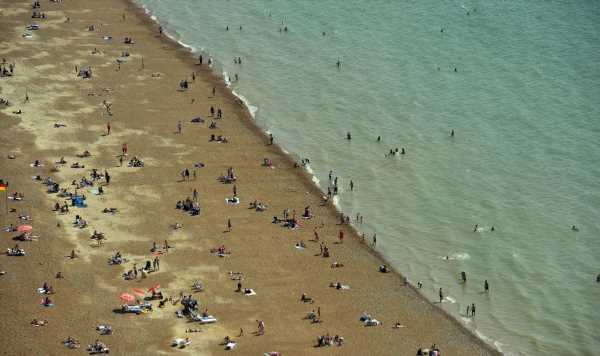El Nino’s weather ‘chaos’ for Britain as expert gives summer heatwave update
A meteorologist has warned summer is not over yet, with chances of a late heatwave intensifying.
Jim Dale, senior meteorologist at British Weather Services, has laid bare the latest weather phenomenon, El Niño, and what it means for Britain’s mercury before autumn hits.
The country has been yo-yo-ing between hot spells, mini heatwaves and thunderstorms for the last month – with June’s prolonged scorcher firmly in the past.
With August, the last full month of summer, merely three weeks away, and the start of the school holidays growing closer, many will be wondering if Britain will be a wash-out for the rest of the season.
The answer in short is not necessarily, Mr Dale said, but that conditions have the potential to rapidly change if El Niño unleashes its full effects on our nation.
READ MORE: Met Office warns ‘heavy, repetitive’ thundery chaos will blight Britain for days
What is El Niño and how will it affect Britain?
The term El Niño is used to describe the warming of the sea surface, and typically occurs every few years. The weather event is declared, the Met Office says, when temperatures in the tropical eastern Pacific rise 0.5C above the long-term average.
This warming up of our oceans has already started – and in fact – its effects are being seen in Europe. Spain, for example, has been forced to endure some extremely hot heatwaves over the start of summer.
It can cause hotter than average temperatures, or indeed go the other way – making winters more cold and wet.
Due to the UK’s position, this country will unlikely feel the full effects of it – but that’s not to say it will not impact the nation’s mercury before summer is out.
Mr Dale told Express.co.uk: “All the climate change & early El Niño action has been elsewhere – in absolute spades.
“For us we remain on the periphery of everything and it will take time yet (the end of month) before we can break free of what we have right now.”
Whether any forthcoming heatwaves can be attributed to El Nino remains to be seen, the expert said. He continued: “El Niño per se will be for others and it should intensify late summer into autumn.
“At that point we may get some crumbs off it, but in what form I’m not entirely sure yet.
“Ocean temperatures are at all time record values across large swathes of the Earth so a heady combination mix in my view will bring more and more chaos, though likely later rather than sooner for us.”
Speaking more literally about what’s in store for the six week school holidays, the weather author predicted August and potentially September could see a resurgence of hot weather.
He added: “There’s time yet and the ocean temperatures could easily lead to more heat in August and September. I guess it could some reaction to El Niño it also but be it won’t be easy to differentiate.
“We are more likely to see impacts for the winter regarding warmth and chaotic weather in my opinion.”
While optimism remains over the chance of more beach-worthy days, the Met Office long-range forecast doesn’t allude to any heatwaves on the horizon.
We use your sign-up to provide content in ways you’ve consented to and to improve our understanding of you. This may include adverts from us and 3rd parties based on our understanding. You can unsubscribe at any time. More info
Don’t miss…
Holidaymakers warned of ‘huge indicator’ that house is empty during summer break[ADVICE]
Brits can avoid biggest ‘travel rip-off’ with simple transport change[LATEST]
Good Morning Britain viewers fume over ‘scare tactics’ following heat warnings[REACTION]
From July 26 to August 9 – the latest time it issues a forecast for, it says cooler conditions may be sticking around. Its long-range forecast says: “Showery conditions most likely continuing, although perhaps winds moving round to the west to northwest.
“Most precipitation still in the form of showers although perhaps some longer spells of rain at times too.
“Temperatures likely to return closer to normal, although the chance of very warm or hot conditions looks to be lower than average.”
Source: Read Full Article




